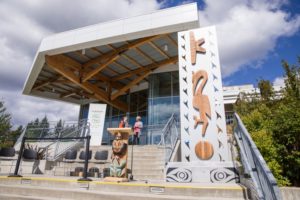On Thursday, September 16, Camosun College celebrated its 50th anniversary with the unveiling of The Cycle of Knowledge house post at its Interurban campus. The house post stands 18 feet tall, and is 2,500 pounds of cedar and aluminium; it was carved by Camosun alumnus Bear Horne. The design on the house post incorporates three elements: the sun, salmon, and blue heron, and it is meant to represent the connection between Camosun and Indigenous communities.
Camosun vice president of education John Boraas says that creating the house post was a community effort.
“When the work began with the house post, we worked with a cross-section of Camosun people to identify the kind of art piece we would like to create,” says Boraas. “This included students of the Indigenous community, faculty, and staff.”

Boraas says that Horne applied to create the piece, and the journey began. It’s not Horne’s first time working with Camosun.
“Bear is a former student who has a relationship with the college,” says Boraas. “He is the artist who made the contribution to the college of the ceremonial podium that the college uses for significant events. He did that as a thank you to the college for the journey he was on.”
Boraas says the three elements on the house post represent the journey of the learning.
“We felt that the depiction of the beginning of the journey with the salmon spawn is represented by the heron fishing, and above that there’s the sun, giving life to everything,” says Boraas. “We felt that was a fitting representation of the learning journey, and the background of the aluminium waves is the sea as a life-giving force reflecting ongoing life given by the power of the sun.”
But it wasn’t all smooth sailing: when COVID-19 hit, everything stopped.
“When the pandemic hit, it was in the middle of it,” says Boraas. “The artist’s work was locked up in a warehouse where he kept his work, and he had no access to it for a year, so that was representative of the pandemonium that has occurred because of COVID-19, unintentionally.”
However, the art ended up unintentionally reflecting the challenges of the time.
“Always when a project starts, we have a clear timeframe… We had a frame of when we would pay the artist, when everything would be presented,” he says. “All of a sudden, we were shut down. The college was going through some serious financial issues. Initially, when we started, all was very strong and all was well, so it was representational of the trials we all went through. That’s not what the intention was, but it was something the project taught us.”
Boraas says that when the unveiling ceremony was finally able to happen, it held great meaning for everyone, especially for Horne, who Boraas describes as “coming of age” and says he is learning a great deal.
“One of the things he asked us to do was schedule the blessing of the house post at a time when his children were there and able to attend, so his children and his parents were there, both local artists represented with spirits of relationships and good intent, so it was a chance for an artist to be supported in his establishment as a notable Coast Salish artist,” says Boraas. “We always prefer if we can to take a bit of a risk on an artist who is developing, rather than supporting a really well-supported artist.”
Boraas says he has made his own connections with the piece.
“I take the drive over to view the house post at different times of the day,” he says. “Depending on the time of the day, the house post is different. So, I encourage people to visit it at different lights, different times, because as a piece of art, seeing it once can’t always capture what it will mean to you.”
Boraas says that erecting a house post that has connections to local First Nations shows the college’s hope for the future of the relationship between post-secondary institutions and Indigenous communities.
“It’s also recognizing that the history of post-secondary education and Indigenous people has not been good,” says Boraas. “Hopefully it’s a way for all of us, Indigenous or not, to think about our place in the past, present, and future in terms of reconciliation.”
Correction: We originally reported the house post was unveiled on Wednesday, September 15. It was actually Thursday, September 16. We apologize for the mistake.
